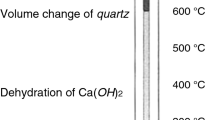Abstract
Properties of cement pastes containing varying amounts of each of polyvinyl alcohol (PVAL), mixtures of polyvinyl alcohol and phenol formaldehyde (PF) and mixtures of poly vinyl alcohol and borax were studied in this paper. Though the strength parameters of the PVAL-cement pastes are comparable to virgin cement paste their resistance to acid is far superior. Soxhlet extraction with water, done to determine leachability of the polymer from the polymer cement paste, revealed that the percentage of polyvinyl alcohol leached out was less when borax or PF resin was added to the PVAL cement paste. The compressive strength of the poly vinyl alcohol–phenol formaldehyde cement paste was found to be inferior to the other two cases but the retention of compressive strength after immersing in each of acid, base and kerosene was much better. In general, polyvinyl alcohol when added to cement pastes improves the chemical resistance properties in terms of retention of compressive strength after exposure to chemicals.
Similar content being viewed by others
References
Ohama Y (1998) Polymer based admixtures. Cem Concr Res 20(2–3):189–212
Puterman M, Malorny W (1996) Some doubts and ideas on the microstructure formation of PCC. In:Proceedings of IX ICPIC Sept.14–18, pp 165–178
Daoud OEK, Ibrahim IA (1996) Impact of environmental and operating conditions in oil refineries on concrete properties. ACI Mater J 93(4):307–317
Wilson Nunes dos Santos (2003) Effect of moisture and porosity on the thermal properties of a conventional refractory concrete. J Eur Ceram Soc 23(5):745–755
Sugama T, Kukacka LE, Horn W (1980) Hydraulic cement-type fillers for hydrothermally stable polymer concretes. J Mater Sci 15(6):1498–1508
Liu YN, Manson JA, Chen WF, Vanderhoff JW (2005) Polymer-Impregnated mortars I. Effect of polymer state on mechanical behavior. Cem Concr Compos 27(9–10):926–933
Larbi JA, Bijen JMJM (1999) A study of interactions between some polymer dispersions and Portland cement during hydration. In: Proceedings of VI ICPIC
Sugama T, Kukacka LE (1979) The effect of dicalcium silicate (C2S) and tricalcium silicate (C3S) on the thermal stability of vinyl-type polymer concrete. Cem Concr Res 9(1):69–76
Larbi JA, Bijen JMJM (1993) Interaction of polymers with Portland cement during hydration: a study of the chemistry of the pore solution of polymer-modified cement systems. Construct Build Mater 7(4):221–229
Puterman M, Malorny W (1998) Some doubts and ideas on the microstructure formation of PCC. Proceedings of IX ICPIC Sept. 14–18
Justnes H, Oye BA (1990) Performance and microstructure of PCC based on epoxy resins; proceedings of VI ICPIC, 1990 Sept 24–27
Schulze Joachim (1999) “Influence of water-cement ratio and cement content on the properties of polymer-modified mortars”. Cem Concr Res 29(6):909–915
Seymour RB, Carraher CE Polymer chemistry, Chapter 7, 3rd edn. Marcel Dekker, New York,213p
Taylor HFW (1997) “Cement chemistry”, 2nd edn. Thomas Telford, London
Semrad E et al (1987) Influence of polymer addition on microscopic and macroscopic properties; Proceedings of V ICPIC, 22–24 Sept. 1987, pp 223–228
Ollitrault-Fichet R,Gauthier C, Clamen G, Boch P (1998) Microstructural aspects in a polymer-modified cement. Cem Concr Res 28(12):1687–1693
Author information
Authors and Affiliations
Corresponding author
Rights and permissions
About this article
Cite this article
Viswanath, P., Thachil, E.T. Properties of polyvinyl alcohol cement pastes. Mater Struct 41, 123–130 (2008). https://doi.org/10.1617/s11527-007-9224-2
Received:
Accepted:
Published:
Issue Date:
DOI: https://doi.org/10.1617/s11527-007-9224-2




